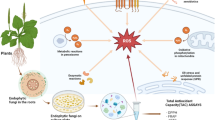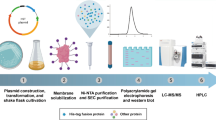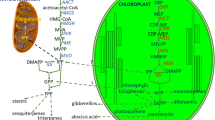Abstract
Cell-suspension cultures of pyrrolizidinealkaloid-producing species selectively take up and accumulate senecionine (sen) and its N-oxide (sen-Nox). Cultures established from non-alkaloid-producing species are unable to accumulate the alkaloids. The uptake and accumulation of 14C-labelled alkaloids was studied using a Senecio vulgaris cell-suspension culture as well as protoplasts and vacuoles derived from it. The alkaloid uptake exhibits all characteristics of a carrier-mediated transport. The uptake of sen-Nox follows a multiphasic saturation kinetics. The Km-values for sen Nox of 53 μM and 310 μM are evaluated. Senecionine competitively inhibits sen-Nox uptake, indicating that the tertiary alkaloid and its N-oxide share the same membrane carrier. The N-oxide of sen shows a pH optimum below 5.5, whereas sen is taken up over a range from pH 4 to 8. Activation energies of 90 and 53 kJ·mol-1 are calculated for sen-Nox and sen transport, respectively. At concentrations of 10 to 100 μM, sen-Nox is rapidly taken up by cells and protoplasts; within 2 h >90% of total N-oxide is within the cells. By contrast the uptake of sen is less efficient. Vacuoles isolated from protoplasts preloaded with sen-Nox totally retained the alkaloid N-oxide, whereas sen is rapidly lost during the procedure of vacuole preparation. N-oxidation converts the weak lipophilic tertiary base into a charged polar molecule which is excellently adapted to serve as the cellular transport and storage form of pyrrolizidine alkaloids.
Similar content being viewed by others
Abbreviations
- CCCP:
-
carbonylcyanide m-chlorophenylhydrazone
- DCCD:
-
N,N′-dicyclohexylcarbodiimide
- DIDS:
-
4,4′-diisothiocyanatostilbene-2,2′-disulfonic acid
- DNP:
-
2,4-dinitrophenol
- sen:
-
senecionine
- sen-Nox:
-
senecionine N-oxide
References
Areshkina, L.J. (1956) Die Alkaloide der Gattung Senecio und ihre Umwandlung in der Planze. Abh. Dtsch. Akad. Wiss. Berlin 7, 196–207
Bagni, N., Pistocchi, R. (1985) Putrescine uptake in Saintpaulia petals. Plant Physiol. 77, 398–402
Bergmeyer, H.U. (1974) Methods in enzymatic analysis. Verlag Chemie, Weinheim
Blackman, M.S., McDaniel, C.N. (1980) Amino acid transport in suspension-cultured plant cells. II. Characterization of L-leucine uptake. Plant Physiol. 66, 261–266
Boppré, M. (1986) Insect pharmacophagously utilizing defensive plant chemicals (pyrrolizidine alkaloids). Naturwissenschaften 73, 17–26
Bull, L.B., Culvenor, C.C.J., Dick, A.T. (1968) The pyrrolizidine alkaloids. North-Holland Publ., Amsterdam
Craig, J.C., Purushothaman, K.K. (1970) An improved preparation of tertiary amine N-oxides. J. Org. Chem. 35, 1721–1722
Culvenor, C.C.J. (1953) Amine oxides. Rev. Pure Appl. Chem. 3, 83–114
Deus-Neumann, B., Zenk, M.H. (1984) A highly selective alkaloid uptake system in vacuoles of higher plants. Planta 162, 250–260
Deus-Neumann, B., Zenk, M.H. (1986) Accumulation of alkaloids in vacuoles does not involve an ion-trap mechanism. Planta 167, 44–53
Ehmke, A., v. Borstel, K., Hartmann, T. (1987) Specific uptake of the N-oxides of pyrrolizidine alkaloids by cells, protoplasts and vacuoles from Senecio cell cultures. In: Plant vacuoles, their importance in solute compartmentation in cells and their application in plant biotechnology, pp. 301–304, Martin, B., ed. Plenum Press, New York
Gaff, D.F., Okong'O-ogala, O. (1971) The use of non-penetrating pigments for testing the survival of cells. J. Exp. Bot. 22, 756–758
Gallagher, S.R., Leonard, R.T. (1982) Effect of vanadate, molybdate and azide on membrane-associated ATPase and soluble phosphatase activities in corn roots. Plant Physiol. 70, 1335–1340
Hartmann, T. (1985) Prinzipien des pflanzlichen Sekundärstoffwechsels. Plant Syst. Evol. 150, 15–34
Hartmann, T., Toppel, G. (1987) Senecionine N-oxide, the primary product of pyrrolizidine alkaloid biosynthesis in root cultures of Senecio vulgaris. Phytochemistry 26, 1639–1643
Hartmann, T., Witte, L., Oprach, F., Toppel, G. (1986) Reinvestigation of the alkaloid composition of Atropa belladonna plants, root cultures, and cell suspension cultures. Planta Med. 390–395
Hartmann, T., Zimmer, M. (1986) Organ-specific distribution and accumulation of pyrrolizidine alkaloids during the life history of two annual Senecio species. J. Plant Physiol. 122, 67–80
Koekemoer, M.J., Warren, F.L. (1951) The Senecio alkaloids. part VIII. The occurrence and preparation of N-oxides. An improved method of extraction of Senecio alkaloids. J. Chem. Soc. 66–68
Kreis, W., Reinhard, E. (1985) Rapid isolation of vacuoles from suspension-cultures Digitalis lanata cells. J. Plant Physiol. 121, 385–390
Kurkdijan, A. (1982) Absorption and accumulation of nicotine by Acer pseudoplatanus and Nicotiana tabacum cells. Physiol. Vég. 20, 73–85
Martinoia, E., Heek, U., Wiemken, A. (1981) Vacuoles as storage compartments for nitrate in barley leaves. Nature 289, 292–294
Matile, P. (1984) Das toxische Kompartiment der Pflanzenzelle. Naturwissenschaften 71, 18–24
Mattocks, A.R. (1971) The occurrence and analysis of pyrrolizidine alkaloid N-oxides. Xenobiotica 1, 451–453
Mattocks, A.R. (1986) Chemistry and toxicology of pyrrolizidine alkaloids. Academic Press, London
Mende, P., Wink, M. (1987) Uptake of the quinolizidine alkaloid lupanine by protoplasts and isolated vacuoles of suspension-cultured Lupinus polyphyllus cells. Diffusion or carrier-mediated transport? J. Plant Physiol. 129, 229–242
O'Neill, S.D., Spanswick, R.M. (1984) Effects of vanadate on the plasma membrane ATPase of red beet and corn. Plant Physiol. 75, 586–591
Parr, A.J., Robins, R.J., Rhodes, M.J.C. (1986) Alkaloid transport in Cinchona ssp cell cultures. Physiol Vég. 24, 419–429
Phillipson, J.D. (1971) Alkaloid N-oxides. Xenobiotica 1, 419–447
Phillipson, J.D., Handa, S.S. (1978a) Alkaloid N-oxides. A review of recent developments. J. Nat. Prod. (Lloydia) 41, 385–431
Phillipson, J.D., Handa, S.S. (1978b) Alkaloid N-oxides in some species of Solanaceae and Papaveraceae. In: Biological oxidation of nitrogen, pp. 409–420, Gorrod, J.W., ed. Elsevier, Amsterdam
Pistocchi, R., Bagni, N., Creus, J.A. (1986) Polyamine uptake, kinetics, and competition among polyamines and between polyamines and cations. Plant Physiol. 80, 556–560
Rea, P.A., Sanders, D. (1987) Tonoplast energetization: Two H+ pumps, one membrane. Physiol. Plant. 71, 131–141
Renaudin, J.P. (1981) Accumulation of the indole alkaloid tabernanthin by cell suspension cultures of Catharanthus roseus and Acer pseudoplatanus. Plant Sci. Lett. 22, 59–69
Renaudin, J.P., Guern, J. (1982) Compartmentation mechanisms of indole alkaloids in cell suspension cultures of Catharanthus roseus. Physiol. Vég. 20, 533–549
Robins, D.J. (1982) The pyrrolizidine alkaloids. Progr. Chem. Nat. Prod. 41, 115–203
Schneider, D. (1987) The strange fate of pyrrolizidine alkaloids. In: Perspectives in chemoreception and behavior, pp. 123–142, Chapman, R.F., Bernays, E.A., Stoffoiano, J.G., eds. Springer, New York
Smith, I.K. (1978) Role of calcium in serine transport into tobacco cells. Plant Physiol. 62, 941–948
Smith, L.W., Culvenor, C.C.J. (1981) Plant sources of hepatotoxic pyrrolizidine alkaloids. J. Nat. Prod. 44, 129–152
Sze, H. (1984) H+-Translocating ATPase of the plasma membrane and tonoplast of plant cells. Physiol. Plant. 61, 683–691
Toppel, G., Witte, L., Riebesehl, B., v. Borstel, K., Hartmann, T. (1987) Alkaloid patterns and biosynthetic capacity of root cultures from some pyrrolizidine alkaloid producing Senecio species. Plant Cell Rep. 6, 466–469
u. Borstel, K., Hartmann, T. (1986) Selective uptake of pyrrolizidine N-oxides by cell suspension cultures from pyrrolizidine alkaloid producing plants. Plant Cell Rep. 5, 39–42
Widholm, J. (1972) The use of fluorescein diacetate and phenosafranine for determining viability of cultured plant cell. Stain Technol. 47, 189–194
Wink, M., Witte, L., Schiebel, H.M., Hartmann, T. (1980) Alkaloid pattern of cell suspension cultures and differentiated plants of Lupinus polyphyllus. Planta Med. 38, 238–245
Author information
Authors and Affiliations
Rights and permissions
About this article
Cite this article
Ehmke, A., von Borstel, K. & Hartmann, T. Alkaloid N-oxides as transport and vacuolar storage compounds of pyrrolizidine alkaloids in Senecio vulgaris L. Planta 176, 83–90 (1988). https://doi.org/10.1007/BF00392483
Received:
Accepted:
Issue Date:
DOI: https://doi.org/10.1007/BF00392483




